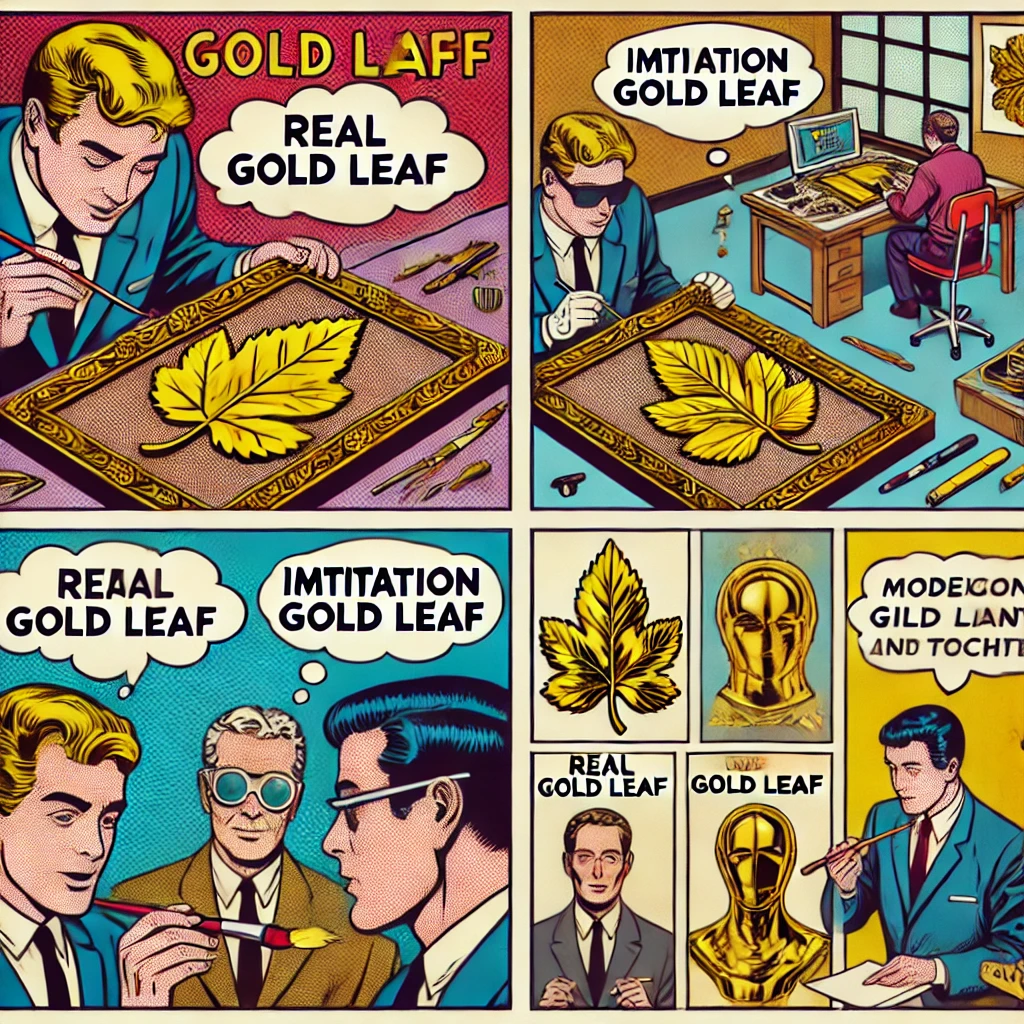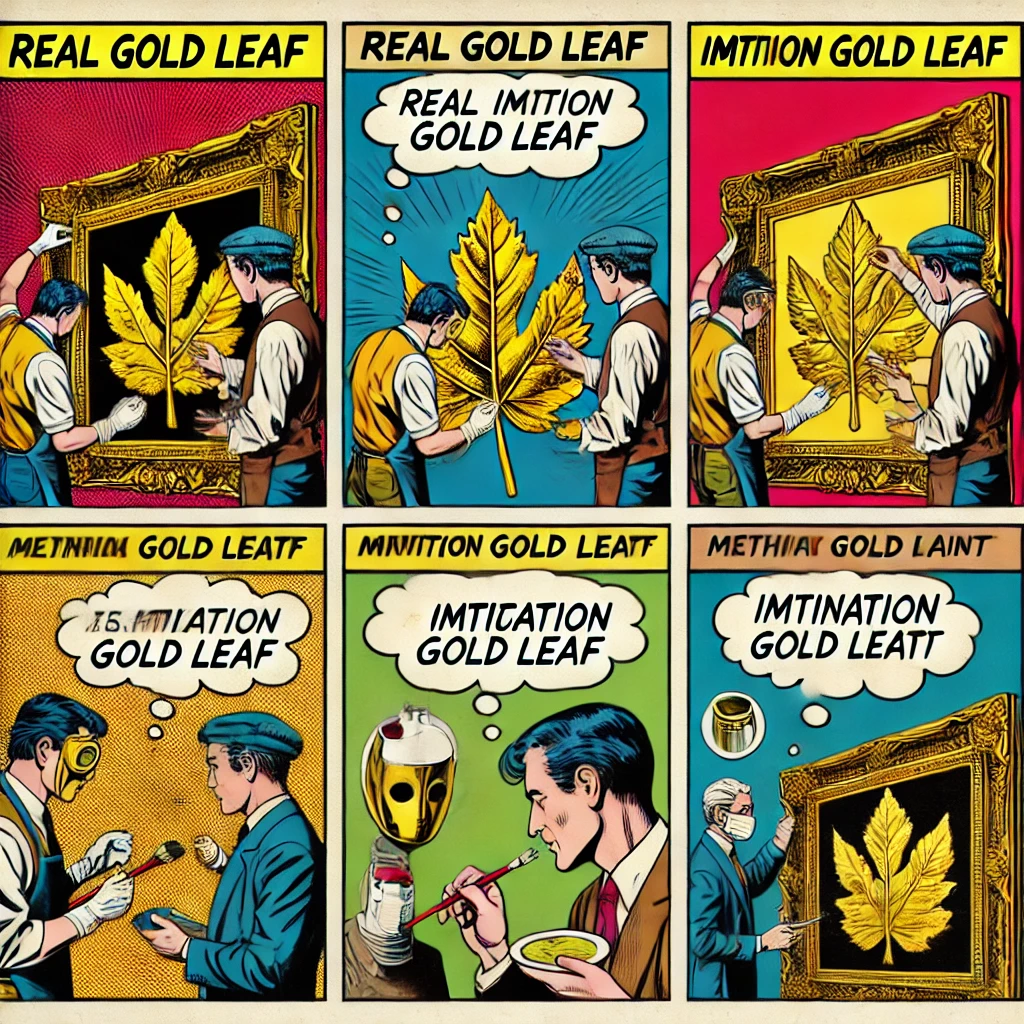Gold Leaf vs Gilding
Gold Leaf and Gilding: An Analysis
Gold Leaf:
- Definition: Gold leaf is a very thin sheet of gold, typically ranging from 22-karat to pure 24-karat gold. It is used in various decorative arts, crafts, and restoration projects.
- Applications:
- Decorative Arts: Applied to furniture, frames, sculptures, and architectural elements.
- Fine Art: Used in paintings, illuminated manuscripts, and religious iconography.
- Luxurious Touch: Adds elegance and value to items like book covers, menus, and interior décor.
- Types:
- Loose Leaf: Delicate sheets requiring special tools and adhesives.
- Transfer Leaf: Backed by wax paper, easier to handle for beginners.
- Imitation Gold Leaf: Made of metals like brass or zinc, more affordable but tarnishes over time.
- Properties:
- Durability: Real gold leaf resists tarnish and corrosion.
- Cost: High, depending on karat and thickness.
Gilding:
- Definition: Gilding refers to the application of gold or gold-like materials to a surface. It can involve gold leaf, gold paint, or even electroplating.
- Techniques:
- Traditional Gilding: Application of gold leaf with adhesive like gilder’s size.
- Oil Gilding: Uses an oil-based adhesive for outdoor durability.
- Water Gilding: A labor-intensive process involving layers of gesso and bole for smooth surfaces.
- Modern Gilding: Incorporates metallic paints or foils for a similar look at a lower cost.
- Materials Used:
- Real gold leaf
- Metal leaf (imitation gold)
- Gold paint
- Gilding wax or powder
- Versatility: Used on wood, metal, glass, ceramics, and leather.
- Cost: Varies significantly based on the material (real gold vs imitation).
Comparison: Gold Leaf vs Gilding
| Aspect | Gold Leaf | Gilding |
|---|---|---|
| Material | Pure or imitation gold | Gold, metallic paints, or foils |
| Application | Directly applied using specialized tools | Broader, includes leafing, painting, and plating |
| Durability | Pure gold is long-lasting and tarnish-resistant | Depends on materials; imitation may tarnish |
| Cost | High (especially pure gold) | Varies widely (affordable options available) |
| Skill Required | High; delicate and requires precision | Varies from beginner-friendly to highly technical |
| Finish Quality | Authentic, luxurious | Varies; can mimic gold leaf or have unique effects |
Becoming an Expert in Gold Leaf Gilding and Sales
Gold Leaf Gilding Expertise:
- Learn the Techniques:
- Practice water gilding, oil gilding, and mordant gilding.
- Experiment with various adhesives and substrates.
- Understand Materials:
- Study the properties of real vs imitation gold leaf.
- Learn about compatible surfaces and preparation techniques.
- Develop Precision Skills:
- Work on handling delicate sheets and achieving smooth finishes.
- Explore Restoration:
- Gain experience in restoring gilded antiques and art.
Sales Expertise in Gilding Products:
- Market Knowledge:
- Understand the needs of artists, decorators, and restorers.
- Keep up with trends in luxury interiors and crafts.
- Product Familiarity:
- Showcase differences between gold leaf, imitation leaf, and modern alternatives.
- Customer Communication:
- Highlight benefits like durability, appearance, and cost-effectiveness.
- Offer tailored solutions for projects (e.g., budget vs premium).
Technical Expertise:
- Deep Dive into Chemistry:
- Learn about adhesives, finishes, and protective coatings.
- Understand chemical interactions that affect durability.
- Experimentation:
- Innovate with mixed media and modern techniques (e.g., gilding on unconventional surfaces).
- Teaching and Sharing:
- Conduct workshops or write guides to establish authority in the field.
By combining artistic skill, technical knowledge, and sales expertise, you can position yourself as a sought-after professional in the gold leaf gilding industry.

